Scottish Salmon and Sea Trout
Catches
Salmon and Sea Trout Catches on
Scottish Rivers
1952 - 2020
|
|
Salmon and sea trout catch statistics for
many of the major Scottish rivers have been selected
from the records gathered annually and held by Marine Scotland
for the Scottish Government and the summarised data have
been combined in the graphs
shown below to illustrate the general trend in
Scottish salmon
catches and sea-trout catches throughout Scotland over the period 1952 to 2020.
Further graphs depict the catches of salmon and sea
trout by anglers from each major Scottish river for that
same period.
Scottish Salmon and Sea Trout Catches
The graph below shows the total
salmon and sea trout rod catches recorded on Scottish
rivers from 1952 to 2020
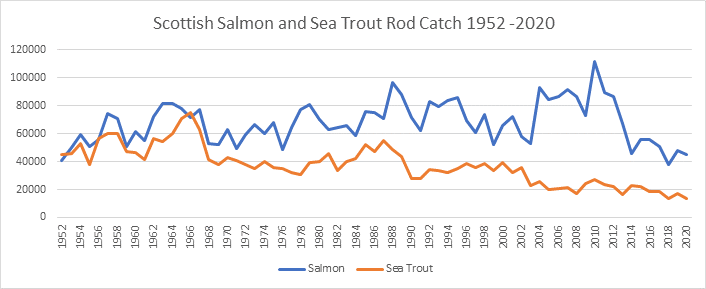
The fishery data held by Marine Scotland are
obtained from returns made annually by the proprietors,
occupiers or agents of salmon and sea trout fisheries
throughout Scotland. Currently over 2,000 forms are issued
annually, of which over 90% are returned.
Each fishery is required
to provide the numbers and total weights of both salmon and sea trout, caught and retained in
each month of the fishing season. Additionally, rod & line
fisheries are required to provide the monthly numbers and
total weights of those salmon, grilse and sea
trout which were legally caught then released
back into the river (caught and released).
Marine Scotland's records are amended when further
information becomes available and updated annually in April
when the statistics for the most recent fishing season are
published.
Top 20 Scottish Salmon Rivers (Rod Catch 2020)
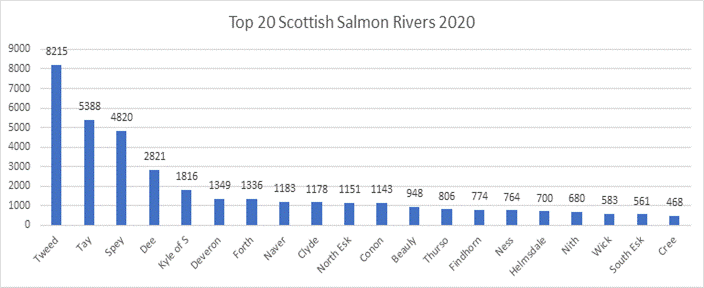
Note that figures are for the
whole river catchments. For example, the Tay includes the
River Earn, the Forth includes the Teith and all minor
tributaries, e.g. the Allan, Carron, Almond etc. The Clyde
includes the River Leven and Loch Lomond system. Ness
includes Loch Ness, Garry and Moriston. Kyle of Sutherland
includes Rivers Oykel, Shin, Cassley and Carron.
Top 20 Scottish Sea Trout Rivers (Rod Catch 2020)
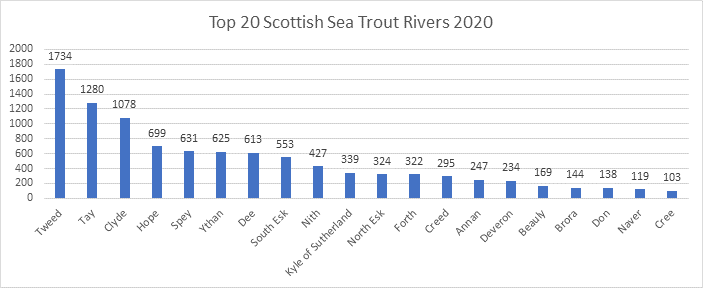
As with the salmon statistics,
figures are for the whole river catchments. For example, the
Tay includes the River Earn, the Forth includes the Teith
and all minor tributaries, e.g. the Allan, Carron, Almond
etc. The Clyde includes the River Leven and Loch Lomond
system. Hope includes river and loch Hope.
Declining Salmon and Sea Trout Numbers on Scotland's Rivers
and Lochs
The total reported rod
catch of wild salmon in Scotland for 2020 was 45,366. This
is the third lowest on record and 92% of the previous 5-year
average. The total reported Scottish rod catch of sea trout
for 2020 was 13,313. This is the lowest on record and 74% of
the previous five year average. Salmon and Sea Trout rod catches
for individual Scottish salmon rivers are shown below in
alphabetical order. The pattern of catches on those rivers
varies widely over the period but the general trend in
catches recorded on many Scottish rivers and lochs in recent
years has been downward. Catches of Scottish sea trout appear to have
been in general and fairly steady decline since the late
nineteen eighties, while Scottish salmon catches have seen a marked
general decline in the last decade. The factors
affecting the numbers of salmon and sea trout returning to
our rivers, and corresponding catches by anglers, are many
and varied. They include climate change, the detrimental
affects of aquaculture (salmon farming), pollution,
predation, poor land and water management, water extraction,
barriers to migration and over-fishing.
See further notes on threats to
our migratory fish at the foot of this page
Salmon and Sea Trout Catch Statistics for the Major Fishing
Rivers of Scotland
Salmon and Sea Trout Catches for each river are shown
below
River Alness Salmon and Sea Trout Catches
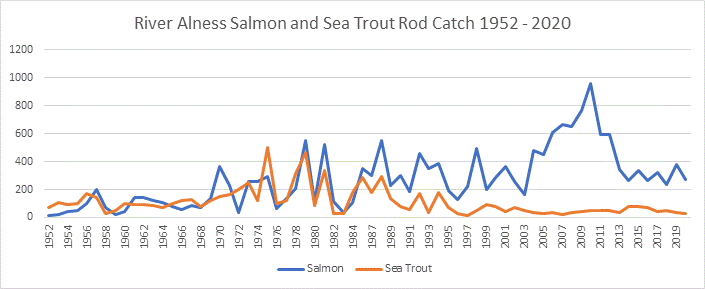
River Annan Salmon and Sea Trout Catches
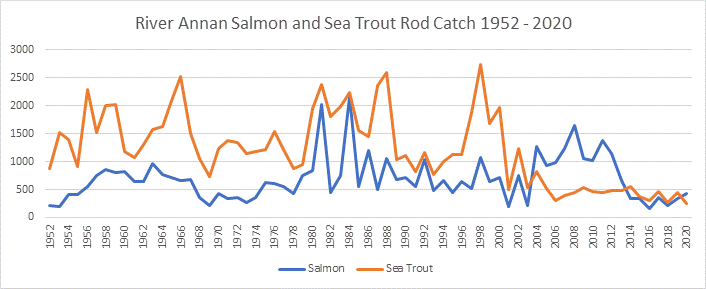
River Awe Salmon and Sea Trout Catches
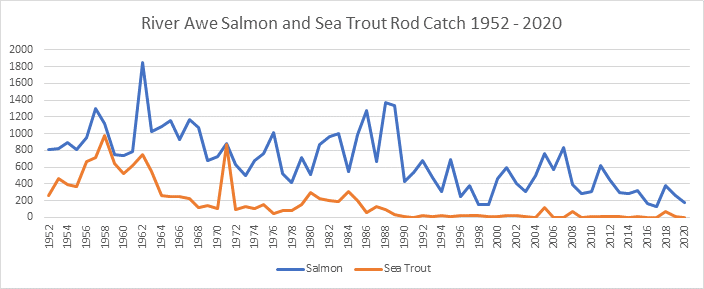
River Ayr Salmon and Sea Trout Catches
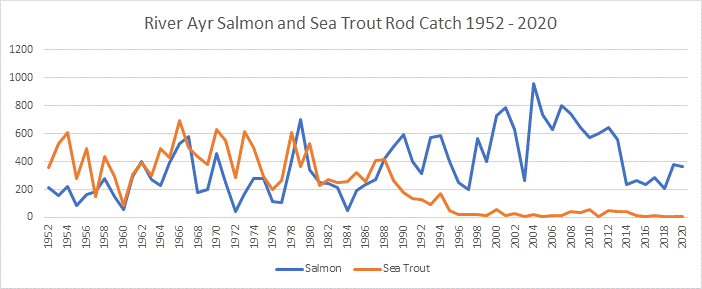
River Beauly Salmon and Sea Trout Catches
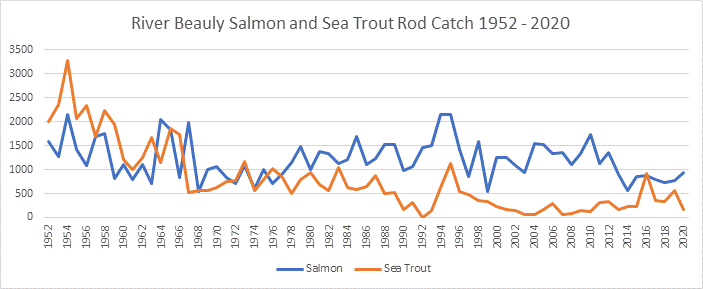
River Bladnoch Salmon and Sea Trout Catches
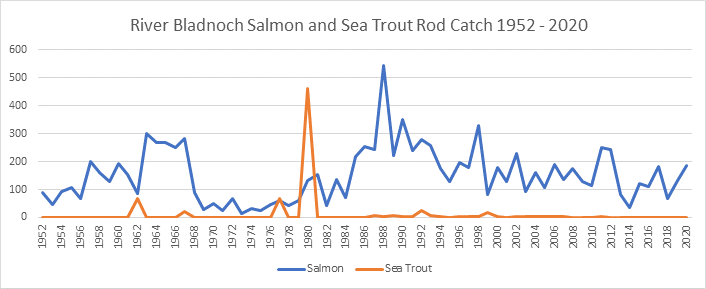
River Brora Salmon and Sea Trout Catches
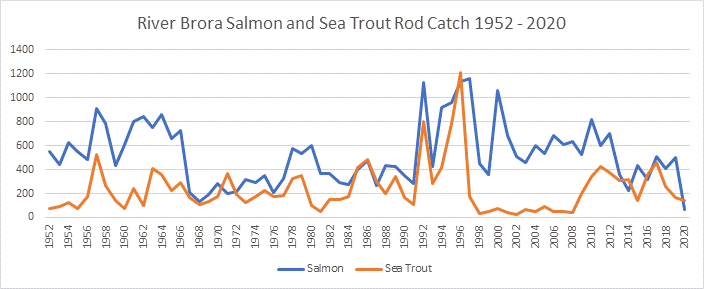
River Carron (Wester Ross) Salmon and Sea Trout Catches
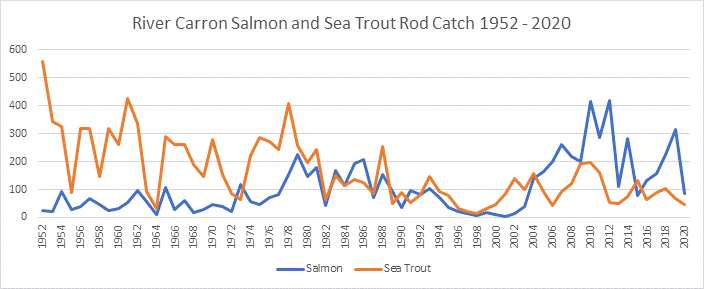
River Clyde Salmon and Sea Trout Catches
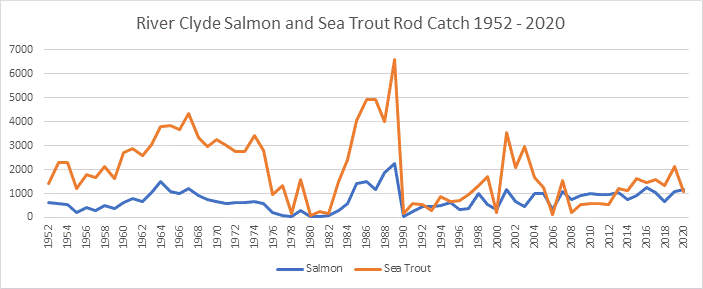
River Conon Salmon and Sea Trout Catches
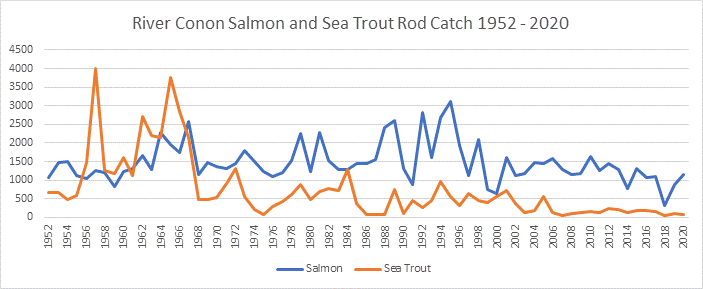
River Cree Salmon and Sea Trout Catches
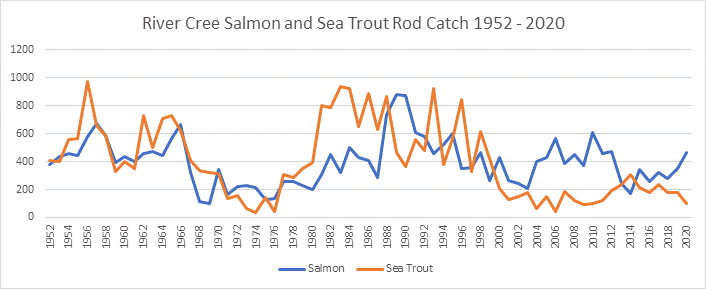
River Creed Salmon and Sea Trout Catches
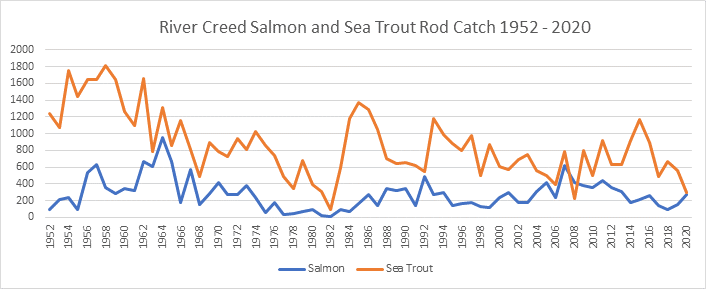
River Dee (Aberdeenshire) Salmon and Sea Trout Catches
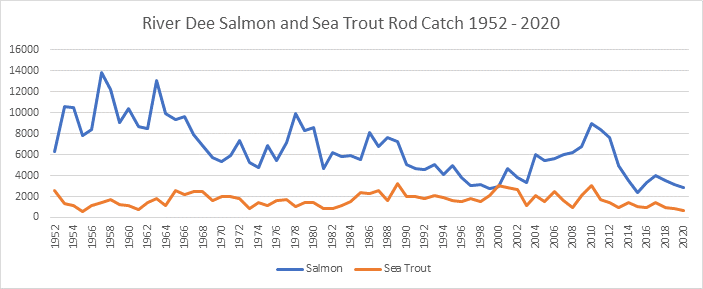
River Deveron Salmon and Sea Trout Catches
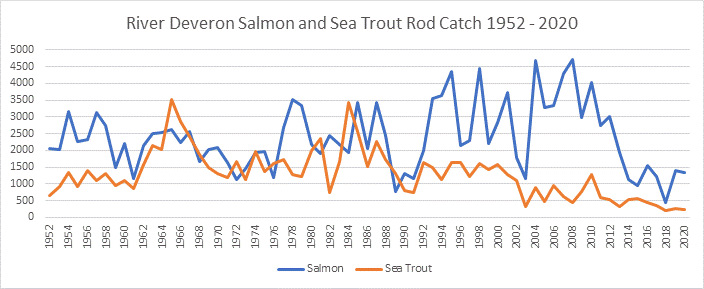
River Don Salmon and Sea Trout Catches
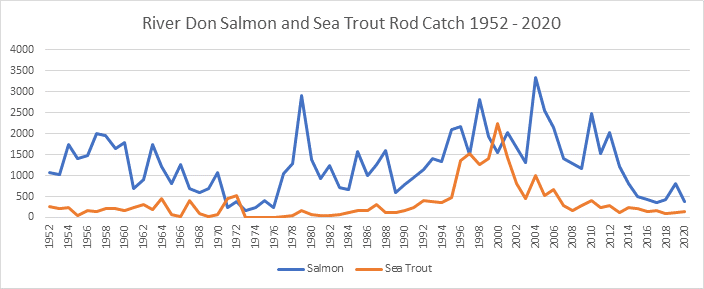
River Doon Salmon and Sea Trout Catches
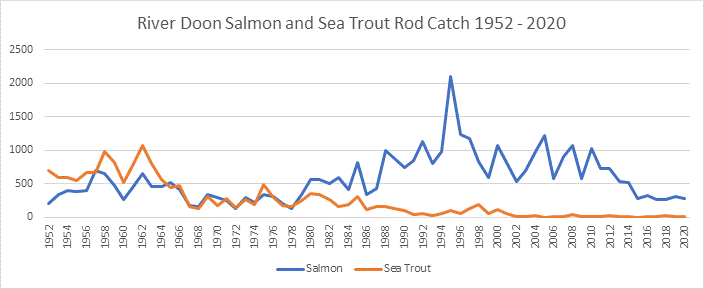
River Ewe Salmon and Sea Trout Catches
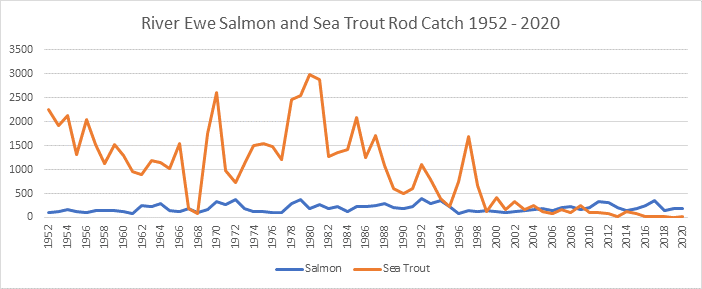
River Findhorn Salmon and Sea Trout Catches
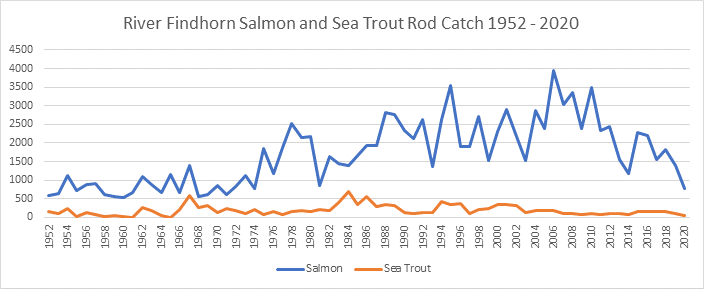
River Forth Salmon and Sea Trout Catches
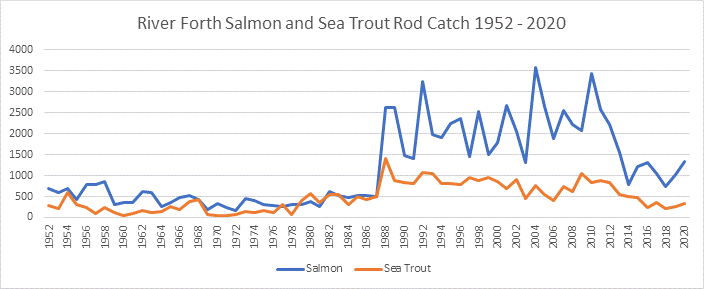
River Girvan Salmon and Sea Trout Catches
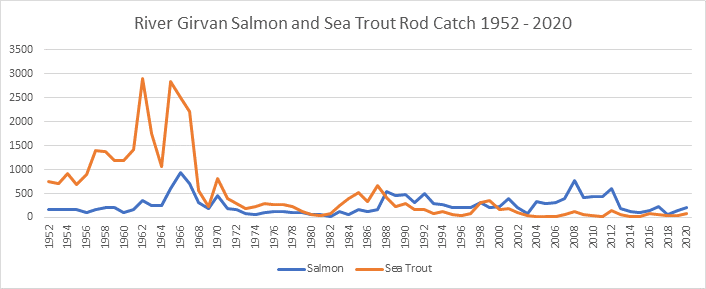
River Halladale Salmon and Sea Trout Catches
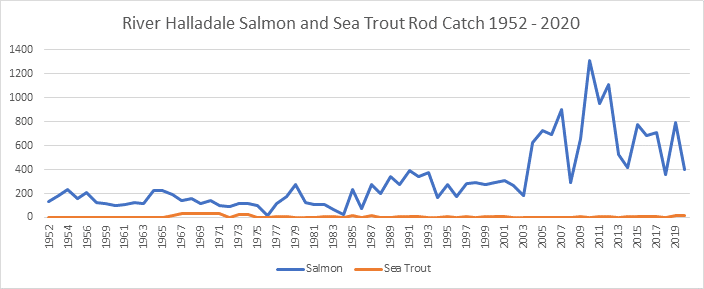
River Helmsdale Salmon and Sea Trout Catches
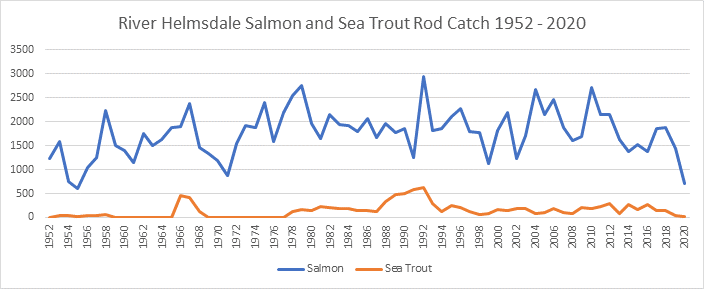
River and Loch Hope Salmon and Sea Trout Catches
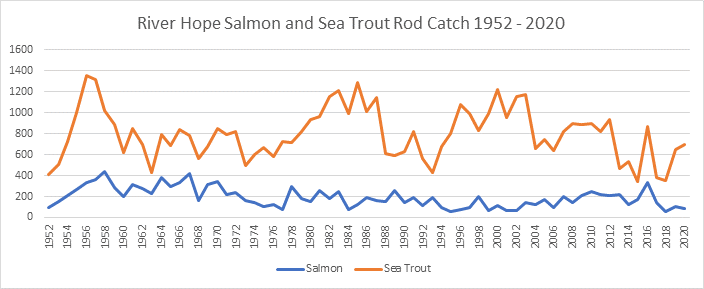
River Inver Salmon and Sea Trout Catches
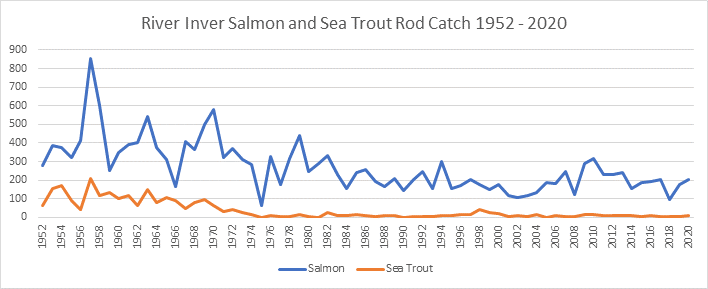
River Irvine Salmon and Sea Trout Catches
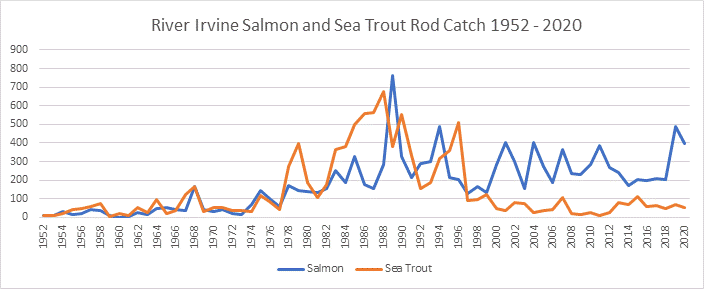
River Kirkaig Salmon and Sea Trout Catches
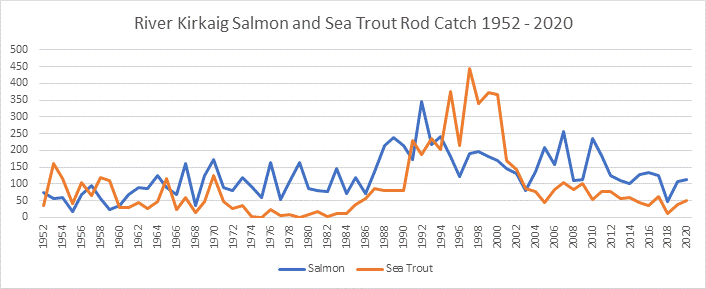
Kyle of Sutherland Salmon and Sea Trout Catches
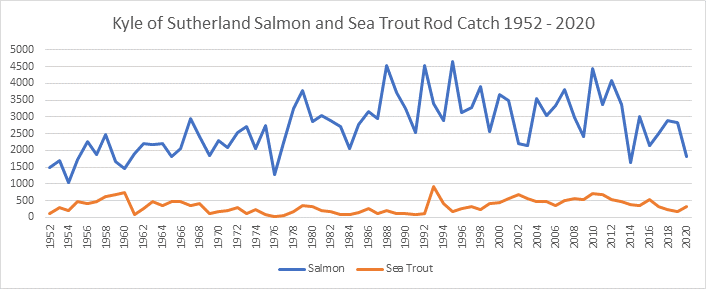
River Laxford (Loch Stack and Loch More) Salmon and Sea Trout Catches
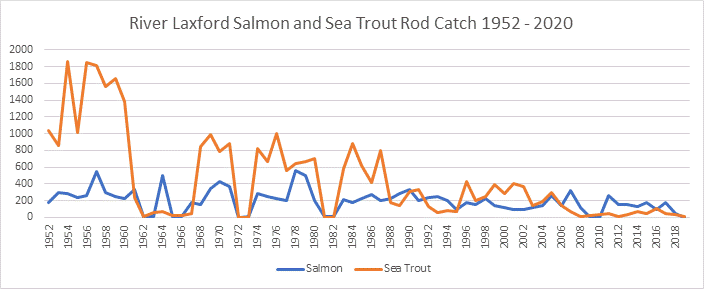
River Lochy Salmon and Sea Trout Catches
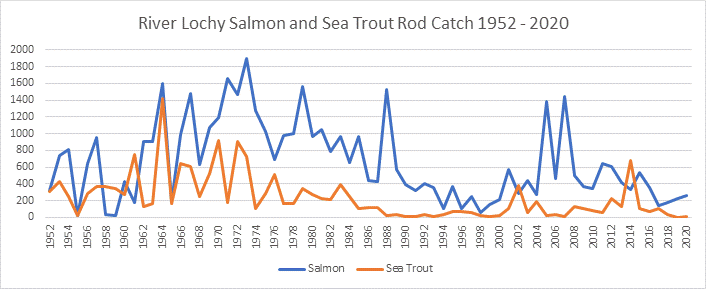
River Lossie Salmon and Sea Trout Catches
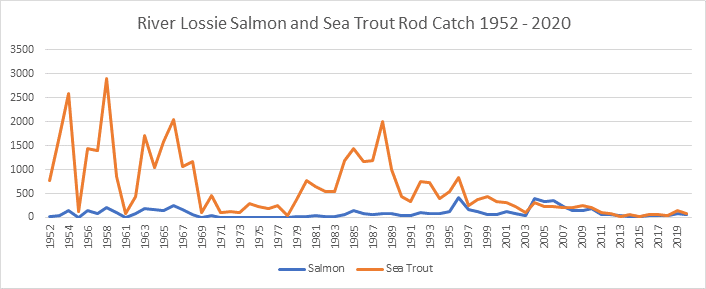
River Luce Salmon and Sea Trout Catches
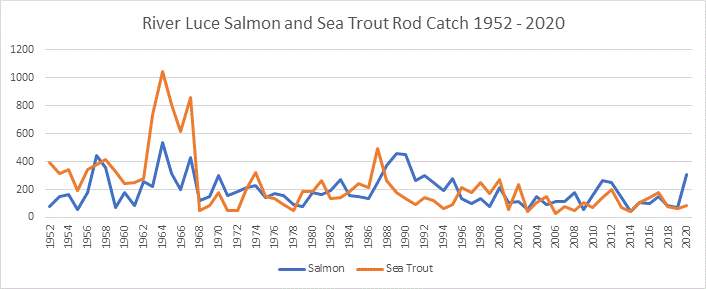
River Nairn Salmon and Sea Trout Catches
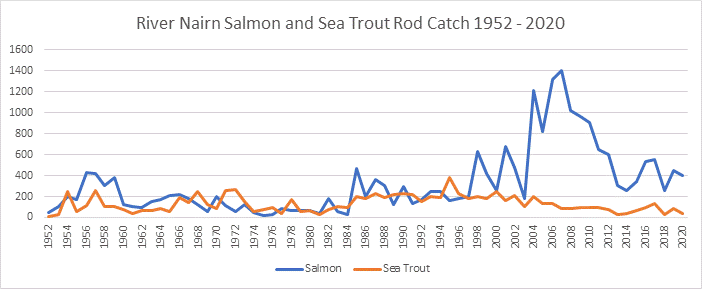
River Naver Salmon and Sea Trout Catches
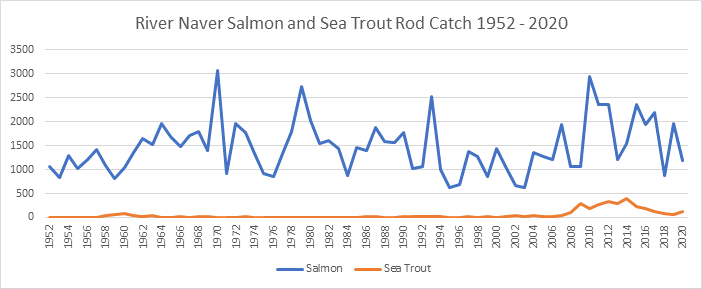
River Ness Salmon and Sea Trout Catches
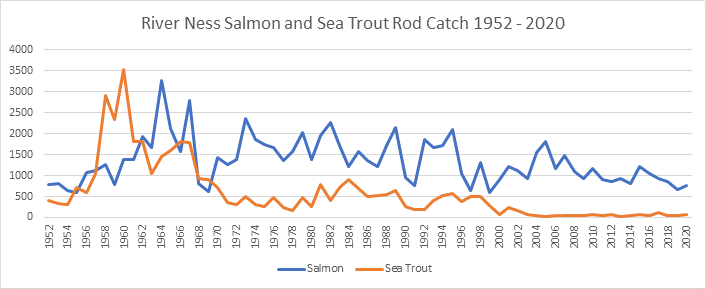
River Nith Salmon and Sea Trout Catches
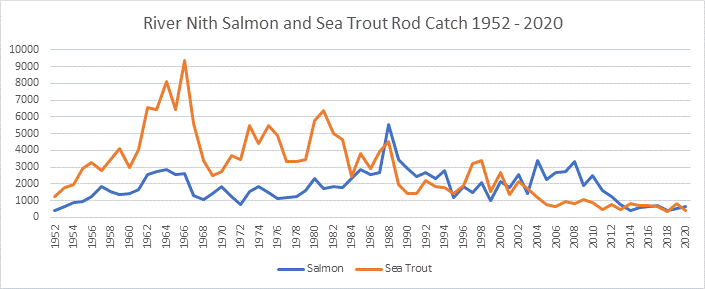
North Esk Salmon and Sea Trout Catches
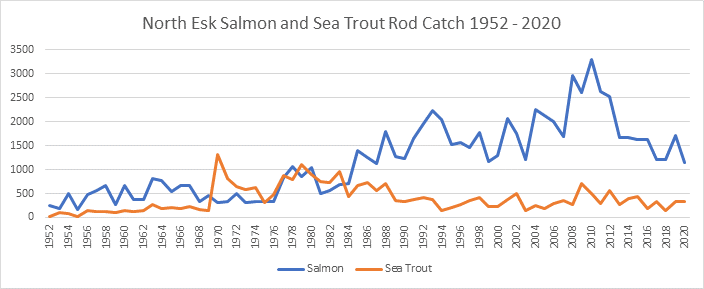
South Esk Salmon and Sea Trout Catches
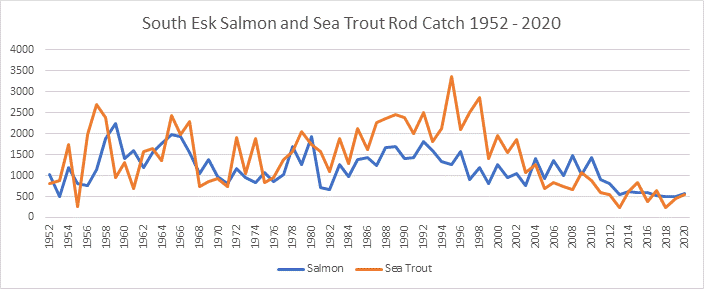
River and Loch Shiel Salmon and Sea Trout Catches
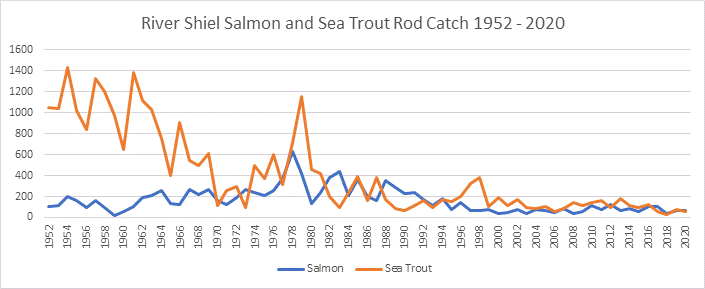
River Spey Salmon and Sea Trout Catches
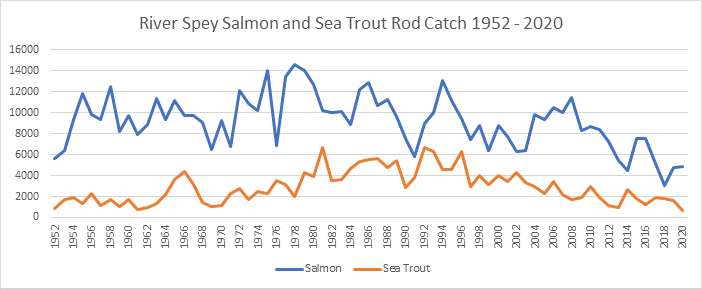
River Stinchar Salmon and Sea Trout Catches
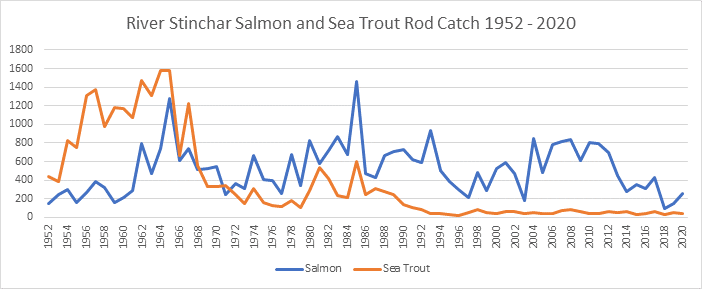
River Thurso Salmon and Sea Trout Catches
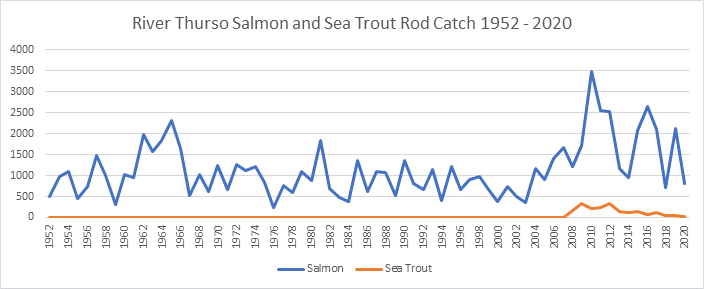
River Tay Salmon and Sea Trout Catches
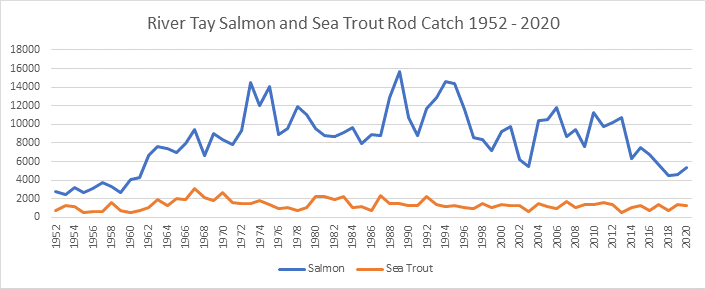
River Tweed Salmon and Sea Trout Catches
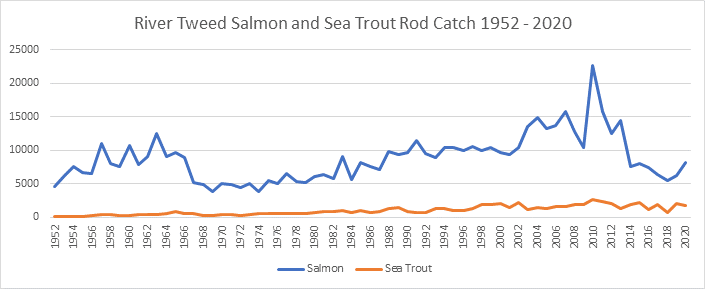
River Ugie Salmon and Sea Trout Catches
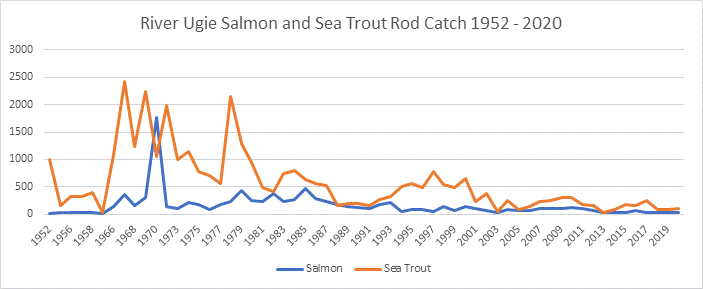
River Urr Salmon and Sea Trout Catches
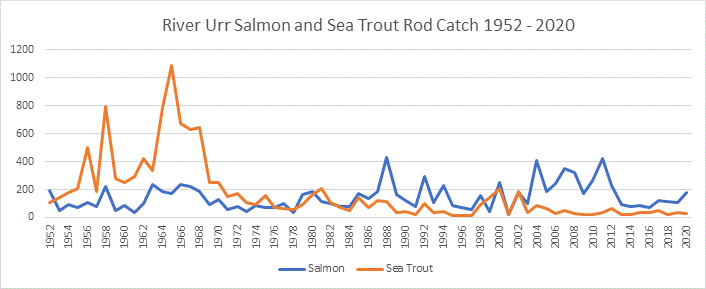
River Wick Salmon and Sea Trout Catches
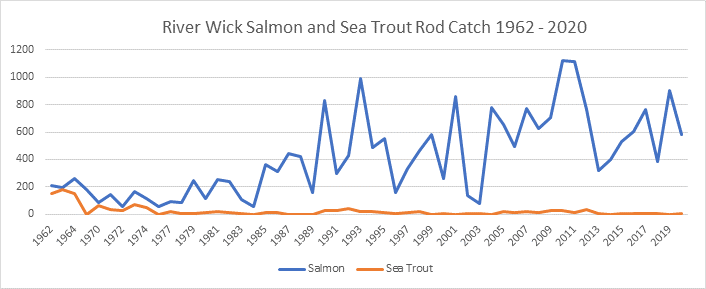 River
Ythan Salmon and Sea Trout Catches
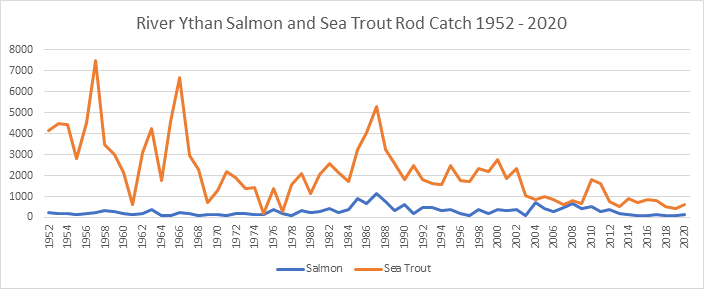
Reasons for Decining Salmon and Sea Trout Stocks in Scotland
Sea trout runs would appear to have
been in general decline in many British rivers since the
late nineteen eighties. The most dramatic, and catastrophic,
decline in sea trout stocks occurred on the west coasts of
Scotland and Ireland, coinciding with the rapid growth of
salmon farms from around the mid nineteen eighties. At one
time, some of the best of our Scottish sea trout fishing was
to be found on the great sea trout lochs of the north west
highlands, on Lochs Maree, Shiel, Eilt, Stack, More and Hope
and on the great loughs of western Ireland. Sadly, the
fishing on the great sea trout lochs is not what it once
was. Stocks of sea trout have collapsed in recent decades.
Catches on the once famous sea trout lochs and rivers are a
mere fraction of what they were. Boats on the lochs lie
idle, hotel rooms empty.
A
scientific study on the sea lice problem associated with the
salmon farms ["Patterns of Sea Lice Infestations on Scottish
West Coast Sea Trout: Survey Results 1997 - 2000" published
by The Association of West Coast Fisheries Trusts] reported:
"In areas with
epizootics (outbreaks of disease affecting many fish at one
time), lice can directly cause the mortality of 30% to 50 %
of all migrating sea trout smolts and 48% to 86% of all wild
salmon smolts..… Studies in Norway, Ireland and Scotland
estimate that, in salmon farming areas, most sea lice larvae
are produced from farmed salmon, due to the far greater
numbers of farmed hosts relative to wild hosts. This is
reflected in significantly higher lice infestations on wild
sea trout in salmon farming zones compared to farm free
areas in Ireland and Norway. Similarly, in Scotland the
highest burdens found on sea trout occurred in the salmon
farming zone of the west coast. Consequently, in Norway,
western Ireland and western Scotland, lice infestations are
regarded as a major factor in the decline of wild salmon and
sea trout populations...."
The
catastrophic impact of salmon farming on stocks of wild sea
trout on the west coast of Scotland is now widely accepted.
A recent report, in 2017, by Dr Andrew F. Walker MSc PhD on
the Collapse of Loch Maree Sea Trout stated:
"Nevertheless, it can be concluded that the introduction of
salmon farming in Loch Ewe close to the River Ewe’s estuary
played a prominent part in the changes in sea trout stock
dynamics in the River Ewe system, leading to the collapse of
the angling fishery in Loch Maree. The rapid change
in sea trout stock structure there in the late 1980s was
consistent with many other badly affected sea trout
fisheries throughout the West Highlands and Islands
following the development of local intensive coastal salmon
farming."
There
can be little doubt as to the extent and nature of the
problem. While the Scottish Government, a strong supporter
of the salmon farming industry, continued to turn a blind
eye to the unfolding environmental catastrophe, it seemed
clear to many of us that the sea lice problem associated
with the salmon farms had been a major contributory factor
in the decline of sea trout stocks on many west coast rivers
and lochs. Salmon stocks face an additional threat from the
many escaping farmed salmon entering our rivers, where they
may interbreed with wild fish, weakening the genetics and
future development of the wild salmon stock. It is to be
hoped that stricter controls combined with improved
production techniques and a growing environmental awareness
on the part of salmon farmers, fishery owners and
politicians might one day halt, and perhaps even reverse,
this sad decline and that the sea trout, and the fishermen,
might one day return to the West Highlands.
In the
meantime, there had been a general, and perhaps more
baffling, decline in sea trout stocks also in areas where no
salmon farms existed, for example in the rivers flowing into
the Moray Firth and Solway Firth. In the summer of 1989, the
Solway rivers appeared to suffer a particularly dramatic
collapse in sea trout runs. Indeed, the total Scottish sea
trout rod catch shows a similar calamitous fall at around
the same time, the 1987 total rod catch of 55,112 sea trout
falling to 48,386 in 1988, 43,285 in 1989 and 28,060 in
1990, a fall of almost 50% in that three year period. The
downward trend in Scottish sea trout rod catches has
continued fairly steadily ever since, to a depressingly low
total of 16,899 in 2019. Why, we might ask, are our sea
trout stocks now in such general decline? It has become
clear that, despite their amazing resilience, our sea trout
face a multitude of threats to their very survival, in both
their marine and freshwater habitats.
I have
noted the grave problem of sea lice infestation associated
with the growth of salmon farming in the north west of
Scotland and in the west of Ireland, undoubtedly a major
factor in the declining fortunes of our sea trout. We may
cite further problems in the marine environment. Gradually
rising sea temperatures, associated with climate change, are
thought to affect the availability and location of many of
the prey species on which salmon, sea trout and other fish
species depend. Over-fishing of salmon at sea increased on
the discovery of the main salmon feeding grounds in the
North Atlantic, while over-fishing of particularly important
prey species such as sandeels around our coasts has
similarly reduced food availability, not only for fish but
also for many of our seabirds.
The uncontrolled growth in
populations of both grey and common seals around our
coastline over the past few decades has posed a severe
predatory threat, while a similar increase in the numbers of
protected species of avian predators, in particular
mergansers, goosanders and cormorants, poses an equally
serious threat to young salmon and sea trout in the river
environment. Sea trout continue to be netted around our
coasts, albeit at a reduced number of locations, now
concentrated along the north east coast of England.
Afforestation in the upper catchments of our rivers has led
to problems of both high levels of acidification and
increased run-off of rainwater, resulting in excessive
erosion in some parts of the river and excessive deposition
in others, both of which may have an adverse impact on sea
trout and salmon spawning streams. Such large and sudden
variations in river flows are likely to be exacerbated by
climatic change which may alter the flow regimes of rivers,
resulting, for instance, in extended drought in summer but
milder, wetter winters causing big winter floods.
While
many historic barriers to sea trout and salmon migration,
such as dams and weirs dating from early industrial times,
have been gradually removed or modified, others are now
appearing in the form of mini hydro-electric schemes, tidal
barriers etc. which hinder both the upward migration of
salmon and sea trout and the downward migration of smolts in
the springtime.
Finally,
while much of the pollution of our rivers from industrial
sources has been reduced dramatically in recent decades,
pollution from other sources has increased. Agricultural
insecticides, pesticides and fertilisers, including slurry,
have found their way, in ever higher concentrations, into
our rivers, with their seriously adverse impact on both fish
and invertebrate life. Despite advances in sewage treatment,
the growth in the size of human settlements on our river
banks has been associated with a general increase in river
pollution in recent times, while the increased demand for
water, for both human and agricultural use, has led to
increasing water abstraction and lower river flows
throughout the increasingly hot and dry summer months.
I have
focussed on sea trout, as they are perhaps more severely
impacted by environmental problems around our coasts. But
many of the problems facing sea trout also have a severely
detrimental impact on stocks of salmon returning to out
rivers. Given the political will, however, many of the above
problems could be addressed, affording a degree of
protection to increasingly fragile stocks of Scottish
salmon and sea trout, our most
valuable game fish.
See also
Trout and Salmon Fishing in Scotland |
|